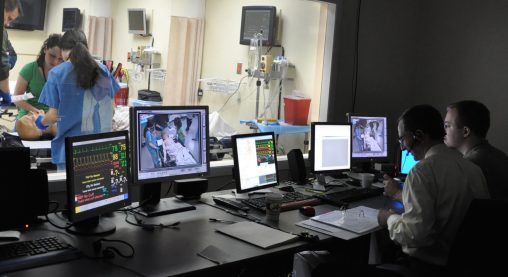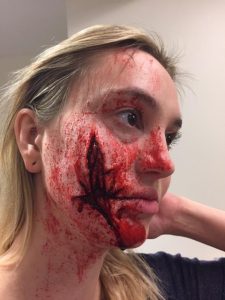
David Shablak, a simulation center technician who works in the Department of Emergency Medicine, uses his moulage skills to depict injuries for students and other educators.
Moulage, the art of applying mock injuries using silicone prosthetics and theatrical makeup, is a widely used technique in training emergency medicine providers. It helps to create a simulation of the gruesome and extreme injuries that first responders will likely face.
At the Wright State University Boonshoft School of Medicine, David Shablak is an expert in moulage. The simulation center technician works in the Department of Emergency Medicine, where his skills with the technique have been used to depict injuries for students and other educators. The department houses the Center for Immersive Medical Education and Research.
Moulage allows Shablak to create lifelike injuries that tease medical students out of the simulation room and make them feel like they’re experiencing a real-life emergency. They have to think on their feet and act quickly to save the simulated patient.
The moulage technique is an incredibly versatile tool in medical education that helps to make emergency medicine training more complete. Unfortunately, it can be mystifying to many working in the field and very costly at times. Shablak hopes to change that.
In January 2019, he will present at the International Medical Simulation in Healthcare Conference in San Antonio, Texas. Shablak will teach a workshop with Lish Robinson, a lead simulation operations specialist at Oregon Health Sciences University. The two will cover everything from moulage’s background to its application.
“Traditionally, moulage can be very daunting for a new educator. Many people do not even know where to start,” Shablak said. “I want to show them that with a few simple approaches, you can quickly achieve your educational goals. Also, I want them to see that moulage does not always have to be complicated and costly.”

Moulage is the art of applying mock injuries using silicone prosthetics and makeup. (Photo courtesy of David Shablak)
The presentation will utilize high-fidelity health care simulation mannequins and task trainers. The mannequins are computerized simulators that play out real-life scenarios. Task trainers help medical students and others to repeatedly practice specific skills.
Shablak’s talk will also cover theory and techniques, with a focus on when and why to use them to highlight their benefits. He hopes to shake up the general perception of moulage and show others its possibilities.
“I hope to challenge what people think is important and give them a new view on how to approach moulage, when it comes to achieving your learning objective in the allotted time and within budget,” Shablak said.
Moulage is part of other efforts at the Boonshoft School of Medicine that utilize simulation to educate the physicians of tomorrow. The medical school is home to the Skills Assessment and Training Center that offers comprehensive clinical training through standardized patients portrayed by actors. Many programs also utilize high-fidelity health care simulation mannequins.

 Wright State, Premier Health hosting surgical symposium for high school and undergraduate students
Wright State, Premier Health hosting surgical symposium for high school and undergraduate students  Wright State joins nation in celebrating first-generation students
Wright State joins nation in celebrating first-generation students  Education grant connects Wright State students with Dayton Regional STEM School for instructional education partnership
Education grant connects Wright State students with Dayton Regional STEM School for instructional education partnership  Wright State recognized among top public universities in latest U.S. News Best Colleges Rankings
Wright State recognized among top public universities in latest U.S. News Best Colleges Rankings  Nearly 1,000 students and alumni turn out for Wright State’s Fall Career and Internship Fair
Nearly 1,000 students and alumni turn out for Wright State’s Fall Career and Internship Fair 